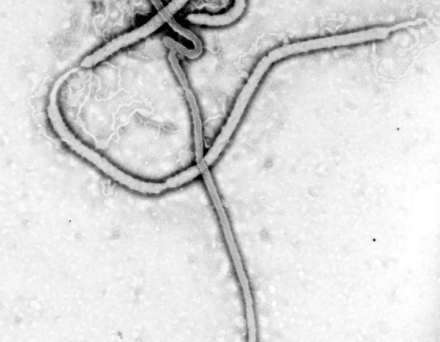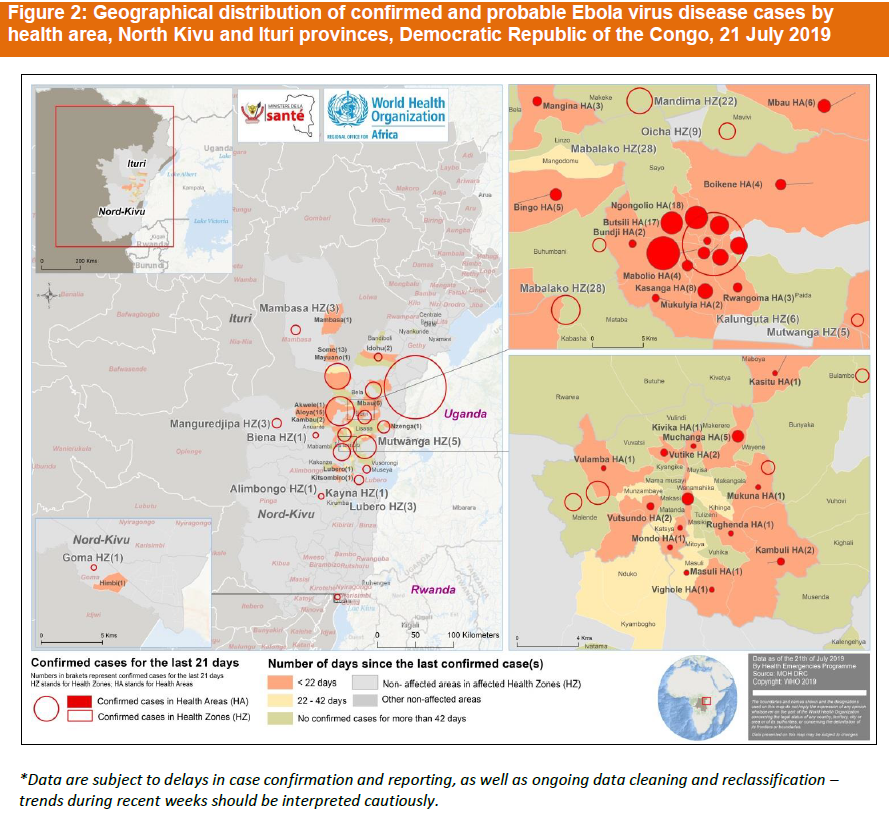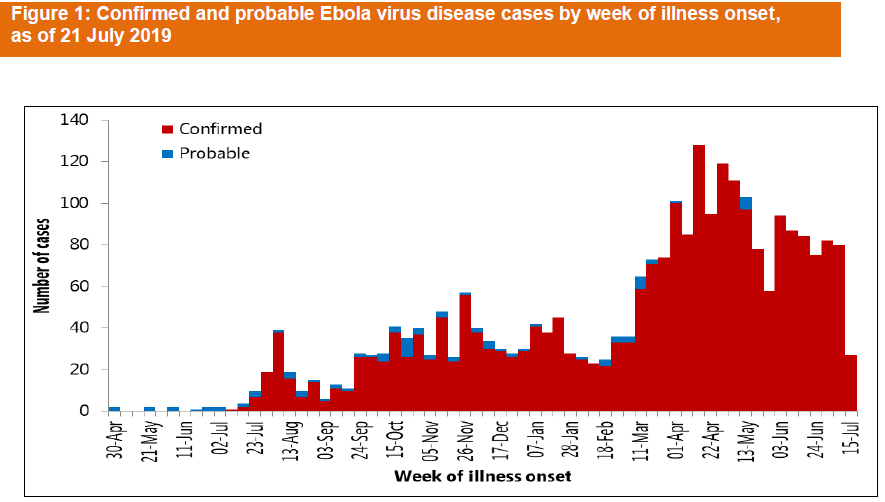
The ongoing Ebola outbreak in the Democratic Republic of Congo that started in August 2018, and has since been largely forgotten amid the flurry of everything else happening throughout the world. However, recent developments, such as the declaration of a Public Health Emergency of International Concern, have attracted renewed attention to the outbreak.
 What is the current situation of this Ebola outbreak in the DRC? At this point, it is the second longest Ebola outbreak, only surpassed by the 2014-2016 outbreak in West Africa. So far, 2592 cases have been reported, of which 1743 have died, with a cumulative fatality rate (CFR) of 67%, which also makes it the second largest Ebola outbreak so far. As you can see above, the outbreak has been concentrated in North Kivu and Ituri provinces, and particularly in Beni, Butembo, Katwa, Mabalako and Mandima health zones. In the last 21 days, most cases have been reported in Beni health zone in North Kivu province. Starting around March of this year, the number of new cases per week increased from about 40 to about 90, and does not show signs of decreasing (see below).
What is the current situation of this Ebola outbreak in the DRC? At this point, it is the second longest Ebola outbreak, only surpassed by the 2014-2016 outbreak in West Africa. So far, 2592 cases have been reported, of which 1743 have died, with a cumulative fatality rate (CFR) of 67%, which also makes it the second largest Ebola outbreak so far. As you can see above, the outbreak has been concentrated in North Kivu and Ituri provinces, and particularly in Beni, Butembo, Katwa, Mabalako and Mandima health zones. In the last 21 days, most cases have been reported in Beni health zone in North Kivu province. Starting around March of this year, the number of new cases per week increased from about 40 to about 90, and does not show signs of decreasing (see below).
 Last Thursday, on the 17th of July 2019, the Director-General of the World Health Organization, Dr. Tedros Adhanom Ghebreyesus, declared this outbreak a Public Health Emergency of International Concern (PHEIC), following the recommendation of the International Health Regulations Emergency Committee. What does this mean? According to the International Health Regulations, a Public Health Emergency of International Concern is defined as “an extraordinary event which is determined, as provided in these Regulations:
Last Thursday, on the 17th of July 2019, the Director-General of the World Health Organization, Dr. Tedros Adhanom Ghebreyesus, declared this outbreak a Public Health Emergency of International Concern (PHEIC), following the recommendation of the International Health Regulations Emergency Committee. What does this mean? According to the International Health Regulations, a Public Health Emergency of International Concern is defined as “an extraordinary event which is determined, as provided in these Regulations:
- to constitute a public health risk to other States through the international spread of disease; and
- to potentially require a coordinated international response”. This definition implies a situation that: is serious, unusual or unexpected; carries implications for public health beyond the affected State’s national border; and may require immediate international action.
So why did the committee recommend to declare the Ebola outbreak in the DRC now, almost a year after the start of this outbreak, a PHEIC? What changed at this point that required such a declaration? Many public health experts advocated that this declaration should have been done earlier. However, if one reads the statement of the International Health Regulations Emergency Committee, it does provide a rationale for the declaration at this time. They listed worrying signs of a possible extension of the epidemic, and concerns of potential geographic spread.
This later point was illustrated by the introduction of the disease into Goma, a city of 2 million people in the DRC. Goma is very close to Rwanda, and there are 15,000 people traveling to and from Rwanda through Goma per day. While the fatal case of Ebola did not lead to secondary cases in Goma, this could happen at other occasions. Previously, a family that was infected by Ebola virus travelled from the DRC to Uganda, where several family members succumbed to the disease, further illustrating the potential of the disease to spread to neighboring countries. This introduction to Goma clearly mobilized authorities to make sure the disease is controlled before it spreads any further, especially since Goma has an international airport, with direct flights to Ethiopia.
In their decision to declare the PHEIC, the committee further cited the ongoing transmission in Beni, challenges in community acceptance and the continued risk for health care workers due to violence. Importantly, they stressed a lack of sustainable and adequate technical assistance, human or financial resources from the global community for outbreak response. The committee recommended that affected countries (such as the DRC) continue to strengthen community awareness, screen potential cases and trace contacts, strengthen surveillance, strengthen measures to prevent nosocomial infections, optimize vaccine strategies and enhance coordination between partners. For neighboring countries, they recommended to improve preparedness for detecting and managing imported cases, predict disease spread, and increase risk communication and community engagement. For all other states, they recommended not to place any travel and trade restrictions, nor implement entry screening at ports of entry outside of the region, as the harm caused by such strategies exceeds the benefits.
This is the first Ebola virus outbreak where an Ebola vaccine was included as part of the response (the same vaccine was used in clinical trials and on an emergency basis towards the end of the 2014-16 West African outbreak). Preliminary data indicates that the VSV-EBOV vaccine is highly efficacious, protecting 97.5% of those vaccinated. Only 71 people out of 94,000 people vaccinated developed Ebola virus disease. 57 of these patients developed disease only 9 days after being vaccinated, potentially indicating that the vaccine did not have enough time to develop protective immunity before exposure. 54 of the 71 cases were high-risk contacts, and only 9 people died, which shows that the vaccine reduced the case fatality rate even if it was administered too late to protect from disease altogether.
So if we have such an effective vaccine, why don’t they just vaccinate everybody? The problem here is supply. So far, 171,052 people have been vaccinated. The manufacturer of the rVSV ZEBOV GP, the German company Merck, has already doubled production in 2020, but with 81.34 million people living in the DRC, there are simply not enough vaccines for everybody. In addition, it might not actually be necessary to vaccinate everyone. The current strategy is ring vaccination, where people who came into contact with infected patients (or their bodies) are vaccinated. A second ring would comprise neighbors and family members of all contacts. The World Health Organization’s Strategic Advisory Group of Experts on Immunization (SAGE) recommended a third ring of contacts to be also vaccinated, but only with a 1/5th dose, which would confer protection after 28 days, according to clinical trials. However, all of these strategies rely on contact tracing, finding those contacts, and their cooperation, which is not straightforward at all.
The declaration of the PHEIC for the Ebola outbreak at the DRC has initiated a series of events since last Thursday. The global health community has pledged more financial and technical support, with the World Bank announcing an additional $300 million dollars to scale up response to the outbreak in the DRC, among many others. In the DRC, President Felix Tshisekedi took over the Ebola response from the Ministry of Health, and appointed Jean-Jacques Muyembe, the head of Congo’s biomedical research institute, who has extensive experience with previous Ebola outbreaks, to coordinate the government’s response. In response, the Minister of Health, Oly Ilunga has resigned from his post. In his resignation letter, he mentioned that he was under pressure to approve a second vaccine, developed by Johnson & Johnson, and supported by the WHO, and incorporate it into the ongoing response. Apparently, Dr. Ilyunga had reservations about this vaccine, and was worried that having two different vaccines would confuse the public and health workers. Johnson and Johnson stood by the quality of their vaccine in a statement. With his departure, it will be interesting to see if this second vaccine will indeed be incorporated into the response. Finally, since the President’s office took over the Ebola response from the Ministry of Health, the daily reports coming out of the Ministry will stop. These reports provided an invaluable resource for the global health community, and it would be a disservice if they would no longer be publicly available. Therefore, I hope that they will be continued by the team lead by Dr. Muyembe.
So where does this leave us? It looks like the Ebola outbreak in the DRC is at a pivotal moment. With the declaration of the PHEIC, additional resources have been committed. Hopefully, this will galvanize the reorganized national response under Dr. Muyembe’s leadership, which will lead to decreased transmission and the end of the current outbreak. However, if the committed resources do not materialize, and the response falters, we are looking at an extension of the epidemic, both in time and potentially geographically. This might provide the Ebola virus the opportunity to become endemic in the human population, and evolve into a genuine human pathogen, sustaining transmission among people. We are very far away from having sufficient herd immunity in the local population, even with the combination of recovery and vaccination. There are also open questions about the ability of vaccinated individuals to shed virus during an asymptomatic infection, and the impact of such individuals on the emergence and persistence of infection.
We all hope that these new developments will help to control the outbreak and most people can forget about this awful virus until it comes back again in the next outbreak!

Comments